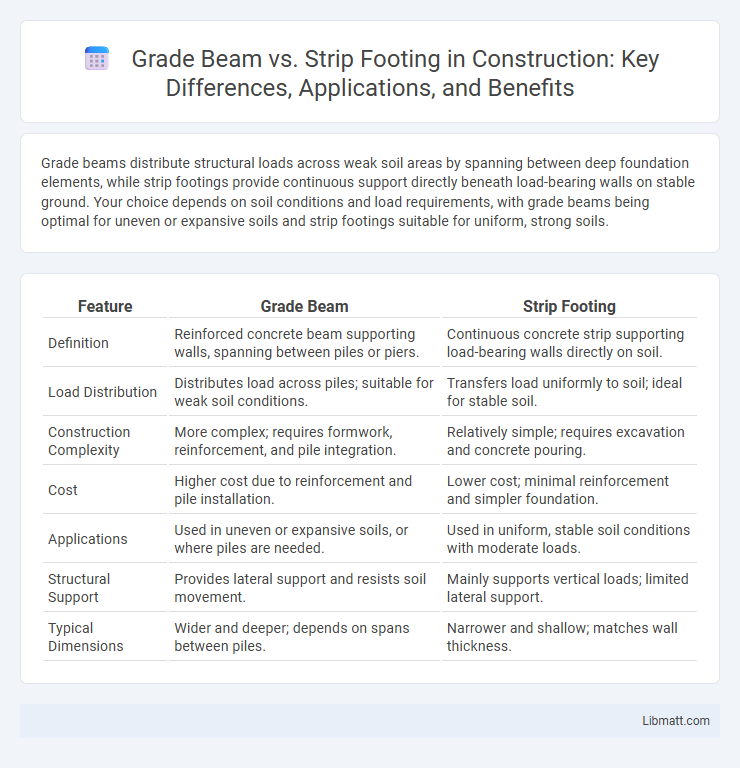Grade beams distribute structural loads across weak soil areas by spanning between deep foundation elements, while strip footings provide continuous support directly beneath load-bearing walls on stable ground. Your choice depends on soil conditions and load requirements, with grade beams being optimal for uneven or expansive soils and strip footings suitable for uniform, strong soils.
Table of Comparison
| Feature | Grade Beam | Strip Footing |
|---|---|---|
| Definition | Reinforced concrete beam supporting walls, spanning between piles or piers. | Continuous concrete strip supporting load-bearing walls directly on soil. |
| Load Distribution | Distributes load across piles; suitable for weak soil conditions. | Transfers load uniformly to soil; ideal for stable soil. |
| Construction Complexity | More complex; requires formwork, reinforcement, and pile integration. | Relatively simple; requires excavation and concrete pouring. |
| Cost | Higher cost due to reinforcement and pile installation. | Lower cost; minimal reinforcement and simpler foundation. |
| Applications | Used in uneven or expansive soils, or where piles are needed. | Used in uniform, stable soil conditions with moderate loads. |
| Structural Support | Provides lateral support and resists soil movement. | Mainly supports vertical loads; limited lateral support. |
| Typical Dimensions | Wider and deeper; depends on spans between piles. | Narrower and shallow; matches wall thickness. |
Introduction to Grade Beams and Strip Footings
Grade beams are reinforced concrete beams that distribute structural loads to isolated footings or piles, providing support between columns or walls. Strip footings, also known as continuous footings, are shallow foundations that run along the length of load-bearing walls, transferring the load directly to the soil. Both are essential in foundation design, with grade beams offering enhanced load distribution and strip footings ensuring stable support for linear structures.
Definition and Construction of Grade Beams
Grade beams are reinforced concrete beams constructed at or near ground level to support walls and distribute loads across unstable soil or spanning over voids. These beams are typically connected to deep foundations, such as piles or drilled shafts, providing lateral support and preventing differential settlement. You benefit from their ability to transfer loads effectively while reducing excavation and construction costs compared to continuous strip footings.
Definition and Construction of Strip Footings
Strip footings are continuous strips of concrete that support load-bearing walls by distributing the structural load evenly over the soil. Constructed by excavating a trench wider than the wall and pouring reinforced concrete, strip footings provide stability for structures with uniform load distribution. Their simple design and cost-effectiveness make them ideal for low to medium-rise buildings on firm soil conditions.
Key Differences Between Grade Beams and Strip Footings
Grade beams transfer structural loads by spanning between piers or piles, providing support over weak soil areas, whereas strip footings distribute loads uniformly along continuous strips under load-bearing walls. Grade beams typically involve reinforced concrete designed to resist bending stresses, while strip footings rely on shallow, wide concrete bases for soil bearing capacity. The choice between grade beams and strip footings hinges on soil conditions, load requirements, and foundation depth needs for structural stability.
Structural Applications: When to Use Grade Beams
Grade beams are ideal for supporting heavy structural loads over weak or expansive soils where strip footings may fail due to differential settlement. Structural applications that require bridging over unstable ground, such as in high-rise buildings or areas with deep foundations, benefit from grade beams' ability to distribute load evenly between piers or piles. Grade beams enhance structural stability in seismic zones by connecting foundational elements and reducing lateral movement.
Structural Applications: When to Use Strip Footings
Strip footings are ideal for supporting load-bearing walls where the soil has adequate bearing capacity and the loads are relatively uniform, such as in residential construction and low-rise buildings. They distribute the weight of the structure along a continuous strip, making them suitable for soils with stable conditions and moderate structural demands. Your choice of strip footing over grade beams depends on ground conditions and the nature of the structural loads.
Advantages of Grade Beams in Foundation Design
Grade beams offer enhanced load distribution across weak or expansive soils, reducing differential settlement risks in foundation design. Their ability to bridge over unstable ground enables your structure to maintain stability even in challenging site conditions. These beams integrate well with deep foundation elements, providing a durable and cost-effective solution for supporting superstructures in diverse construction projects.
Advantages of Strip Footings in Foundation Design
Strip footings provide continuous support for load-bearing walls, distributing structural weight evenly across the soil and reducing settlement risks compared to isolated footings. Their simple construction and cost-effectiveness make them ideal for uniform soil conditions and low to moderate load requirements, ensuring efficient use of materials and labor. Choosing strip footings can enhance the stability and durability of your foundation, especially for residential and light commercial buildings.
Cost Comparison: Grade Beam vs Strip Footing
Grade beams typically incur higher construction costs than strip footings due to the additional materials and labor required for reinforced concrete and formwork installation. Strip footings, often simpler in design, use less concrete and reinforcement, making them a more economical choice for uniform soil conditions and lighter loads. Project complexity and soil bearing capacity significantly influence the cost-effectiveness of either foundation system.
Choosing the Right Foundation for Your Project
Choosing the right foundation, such as a grade beam or strip footing, depends on soil conditions and load requirements. Grade beams are ideal for supporting heavy loads over weak soil by spanning between piles or piers, while strip footings work well for uniform soil with moderate load-bearing capacity. Your decision should consider structural needs, soil analysis, and project budget to ensure stability and longevity.
Grade beam vs Strip footing Infographic

 libmatt.com
libmatt.com